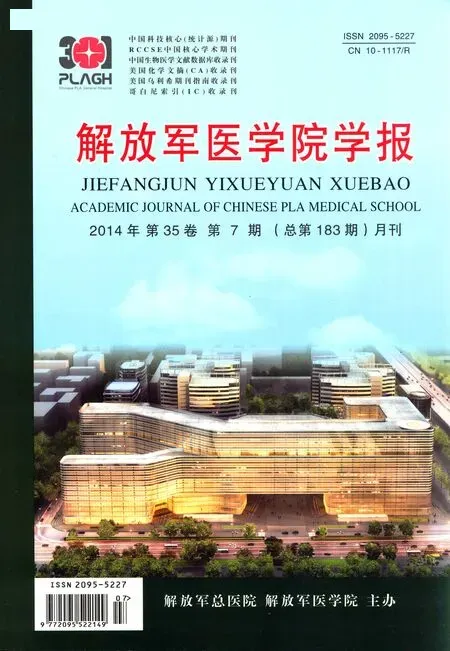脑小血管病发病机制和神经影像学特征
梁永平,李宝民,潘 卿
解放军总医院 神经外科,北京 100853
脑小血管病发病机制和神经影像学特征
梁永平,李宝民,潘 卿
解放军总医院 神经外科,北京 100853
脑小血管病极为常见,其引起的症状性与无症状性小卒中患者数量逐年提高。内皮功能障碍、血脑屏障受损、缺血和低灌注损伤及遗传因素都被认为与脑小血管病发病密切相关。脑深部小梗死、脑白质病变、脑微出血及血管周围间隙扩大被公认为是脑小血管病的影像学标志。本文对脑小血管病的发病机制和常见影像学表现作一综述。
脑小血管病;磁共振成像;脑白质病变
脑小血管病(cerebral small vessel diseases,CSVD)主要指脑的小穿支动脉和小动脉(直径40 ~ 200 μm)、毛细血管及小静脉的各种病变所导致的临床表现、认知功能、影像学及病理学表现,是引起血管性痴呆及年龄相关性认知功能减低的主要原因,占所有缺血性脑卒中的10% ~ 30%[1-4]。现就脑小血管病的发病机制和影像学特征做一综述。
1 脑小血管病的发病机制
内皮功能障碍、血脑屏障(blood brain barrier,BBB)受损、缺血和低灌注损伤及遗传因素都被认为与脑小血管病发病密切相关,且这些机制并非独立存在,它们相互影响和作用,共同导致了CSVD的发生[5]。最近研究提示,由炎性机制及氧化应激导致的血管内皮功能紊乱在脑白质损害(white matter lesion,WML)中扮演着十分重要的角色[6]。同型半胱氨酸(homocysteine,Hcy)所引起的氧化应激是目前研究得较多的CSVD危险因素,Hcy通过调节NO信号通路、增强氧化及硝化反应引起内皮损伤可能是CSVD相关内皮功能紊乱的原因之一[7]。Kimura等[8]的研究显示,老年CSVD患者血清抗内皮细胞抗体水平显著高于正常老年人,从而提示内皮细胞损伤是导致CSVD发生的原因之一。但近期Stevenson等[9]通过系统回顾显示,在普通脑梗死病人中也普遍存在血管内皮功能紊乱,所以血管内皮功能紊乱不能认为是脑小血管病相关性梗死的特异性因素。同时Giwa等[10]通过对局部组织进行病理检查证实遗传性和非遗传性CSVD患者深穿支动脉组织中的炎性介质无明显差异,说明深穿支动脉的内皮激活与CSVD无关。
脑小血管大多为终末血管,吻合支较少,这种解剖学特性使其供血区很容易出现低灌注和缺血性损伤。低灌注所引起的缺血可能是CSVD的重要发病机制之一。Nezu等[11]对一组除外大血管病变的腔隙性卒中患者进行正电子发射体层摄影(positron emission tomography,PET),与轻微WML组相比,重度WML组半卵圆中心脑血流量较低、氧摄取率较高、脑氧代谢率较低。O’Sullivan等[12]应用磁共振灌注成像技术发现,在看似正常的白质中也存在脑血流量下降。
血脑屏障的损伤也被证实是CSVD的可能原因之一。血脑屏障受损后,血浆内大分子成分可进入血管周围脑组织而引起损伤。Schreiber等[13]通过回顾大鼠模型相关文献发现,BBB功能紊乱引起小血管结构改变和血管周围组织病理生理改变,可能是各种类型脑小血管病发生的启动因素。Wardlaw等[14]通过对70例有腔隙性脑梗死及小的皮质梗死的患者随访3年发现,神经功能不佳评分与基底节区血脑屏障通透性呈正相关。
遗传因素特别是基因型与CSVD的发生也是目前研究的热点。近期研究表明NOTCH3基因可引起脑常染色体显性遗传伴皮质下梗死和白质脑病(CADASIL),NOTCH3基因表达蛋白是CADASIL发生的决定因素[15]。同时有研究通过对高血压人群年龄相关性WML的风险评估提示NOTCH3基因突变不但对遗传性CSVD有影响,而且对非遗传性CSVD脑小血管病也有影响[16]。
2 脑小血管的影像学研究
脑深部小梗死又称皮质下小梗死,影像学上主要表现为腔隙脑梗死(lacunar infarction,LI)及腔隙(1acuna)[17]。症状性脑深部小梗死占所有症状性脑卒中的20% ~ 30%,其在发达国家老年人中的年发病率可达到0.33/1 000[18]。急性脑深部小梗死最可靠的诊断技术是磁共振弥散加权成像(DWI),表现为液体衰减反转恢复(fluidattenuated inversion recovery,FLAIR)序列上的高信号。慢性脑深部小梗死在磁共振检查上主要表现为在基底节区、内囊和脑桥部位的T1和FLAIR序列上的低信号,通常还伴有FLAIR序列上的环形高信号[4]。
脑白质病变又称年龄相关性脑白质病变,尽管多与脑深部小梗死共存,但两者是有区别的。WML在60岁以上白种人中的发病率可达80%,约2/3的老年痴呆及1/3的阿尔茨海默病患者中同样伴发有WML[19]。WML在MRI上主要表现为在深部白质或脑室旁的T1序列上等信号或偏低信号、FLAIR和T2序列高信号的病灶。虽然与高分辨的T2序列相比,FLAIR序列可能无法很好显示丘脑及后颅窝病灶,但在临床实际中FLAIR序列还是首选。目前有多种研究方法试图通过计算WML的病灶体积来寻找一个针对WML敏感的评估方法[20]。同时通过磁共振弥散张量成像(diffusion tension imaging,DTI)可进一步对比正常白质与WML的白质传导束包膜完整性,以期进一步深入研究WML[21]。需要说明的是目前成为研究热点的高场强磁共振(>7 T)在脑小血管病特别是WML和脑微出血的影像学诊断上较普通磁共振(1.5 T)并没有明显优势[22]。
随着磁共振检查技术的提高和普及,脑微出血(cerebral microbleeds,CMB)检出率也逐渐提高。在无明显认知功能损害的老年人群体中,CMB罹患率为11% ~ 25%[23]。CMB在磁共振检查的梯度回波(gradient recalled echo,GRE)序列上可以观察出血灶内老的或较新的含铁血黄素沉着,主要表现为圆形或卵圆形,无周围水肿的低信号影。CMB病灶在磁共振磁敏感加权成像(susceptibility weighted imaging,SWI)序列同样表现为低信号,但相比于GRE序列,SWI序列具有更高的灵敏度和特异性,研究表明通过SWI序列筛选出的CMB病灶只有约1/3在GRE序列上同样呈现阳性[24]。同时CBM的检出率与各序列参数设定及判别标准也有一定关系。
小血管脑病患者中血管周围间隙扩大也越来越受到学者的重视。血管周围间隙扩大常见于老年人磁共振影像,表现为围绕着小的穿支动脉周围的脑脊液填充,并且随着年龄的增长,血管周围间隙扩大的发生率也逐渐增加。磁共振成像上主要为直径<2 mm的T2序列上的高信号,T1及FLAIR序列上的低信号。
尽管脑深部小梗死、WML、CMB及血管周围间隙扩大被公认为脑小血管病的影像学标志,但在最新脑小血管病的诊治专家共识中也指出了实际诊断时需注意的3点:1)4种影像学标志并非CSVD的特有表现,也可见于其他中枢神经系统疾病;2)4种影像学标志的任何1个诊断特异性均低,但多个同时存在则能极大地提高诊断特异性;3)4种影像学标志均随年龄增长而显著增加,在正常老年人和有临床意义的CSVD患者中并无严重程度的绝对界限,因此诊断必须结合临床表现,避免过度泛化[2]。
1 Wardlaw JM, Smith C, Dichgans M. Mechanisms of sporadic cerebral small vessel disease: insights from neuroimaging[J]. Lancet Neurol, 2013, 12(5): 483-497.
2 脑小血管病诊治专家共识组.脑小血管病诊治专家共识[J].中国临床医生,2014,10(1):84-87.
3 Chabriat H, Mrissa R, Levy C, et al. Brain stem MRI signal abnormalities in CADASIL[J]. Stroke, 1999, 30(2): 457-459.
4 Patel B, Markus HS. Magnetic resonance imaging in cerebral small vessel disease and its use as a surrogate disease marker[J]. Int J Stroke, 2011, 6(1): 47-59.
5 唐杰,付建辉.脑小血管病的发病机制[J].国际脑血管病杂志,2013,21(4):293-298.
6 Grueter BE, Schulz UG. Age-related cerebral white matter disease(leukoaraiosis): a review[J]. Postgrad Med J, 2012, 88(136):79-87.
7 Jeong SK, Kim DH, Cho YI. Homocysteine and pulsatility index in lacunar infarction[J]. Clin Neurol Neurosurg, 2011, 113(6):459-463.
8 Kimura A, Sakurai T, Yamada M, et al. Anti-endothelial cell antibodies in patients with cerebral small vessel disease[J]. Curr Neurovasc Res, 2012, 9(4): 296-301.
9 Stevenson SF, Doubal FN, Shuler K, et al. A systematic review of dynamic cerebral and peripheral endothelial function in lacunar stroke versus controls[J]. Stroke, 2010, 41(6): e434-e442.
10 Giwa MO, Williams J, Elderfield K, et al. Neuropathologic evidence of endothelial changes in cerebral small vessel disease[J]. Neurology, 2012, 78(3): 167-174.
11 Nezu T, Yokota C, Uehara T, et al. Preserved acetazolamide reactivity in lacunar patients with severe white-matter lesions: 15O-labeled gas and H2O positron emission tomography studies[J]. J Cereb Blood Flow Metab, 2012, 32(5): 844-850.
12 O’sullivan M, Lythgoe DJ, Pereira AC, et al. Patterns of cerebral blood flow reduction in patients with ischemic leukoaraiosis[J]. Neurology, 2002, 59(3): 321-326.
13 Schreiber S, Bueche CZ, Garz C, et al. Blood brain barrier breakdown as the starting point of cerebral small vessel disease? -New insights from a rat model[J]. Exp Transl Stroke Med, 2013, 5(1): 4.
14 Wardlaw JM, Doubal FN, Valdes-Hernandez M, et al. Blood-brain barrier permeability and long-term clinical and imaging outcomes in cerebral small vessel disease[J]. Stroke, 2013, 44(2): 525-527.
15 Arboleda-Velasquez JF, Zhou Z, Shin HK, et al. Linking notch signaling to ischemic stroke[J]. Proc Natl Acad Sci U S A, 2008,105(12): 4856-4861.
16 Schmidt H, Zeginigg M, Wiltgen M, et al. Genetic variants of the NOTCH3 gene in the elderly and magnetic resonance imaging correlates of age-related cerebral small vessel disease[J]. Brain,2011, 134(Pt 11): 3384-3397.
17 Donnan G, Norrving B, Bamford J, et al. Subcortical stroke,2nd edn[M]. New York : oxford university press, 2002.
18 Sudlow CL, Warlow CP. Comparable studies of the incidence of strokeand its pathological types: results from an international collaboration. International Stroke Incidence Collaboration[J]. Stroke, 1997, 28(3): 491-499.
19 Moran C, Phan TG, Srikanth VK. Cerebral small vessel disease: a review of clinical, radiological, and histopathological phenotypes[J]. Int J Stroke, 2012, 7(1): 36-46.
20 Beare R, Srikanth V, Chen J, et al. Development and validation of morphological segmentation of age-related cerebral white matter hyperintensities[J]. Neuroimage, 2009, 47(1): 199-203.
21 de Laat KF, van Norden AG, Gons RA, et al. Diffusion tensor imaging and gait in elderly persons with cerebral small vessel disease[J]. Stroke, 2011, 42(2): 373-379.
22 Theysohn JM, Kraff O, Maderwald S, et al. 7 tesla MRI of microbleeds and white matter lesions as seen in vascular dementia[J]. J Magn Reson Imaging, 2011, 33(4): 782-791.
23 Poels MM, Ikram MA, van der Lugt A, et al. Incidence of cerebral microbleeds in the general population: the Rotterdam Scan Study[J]. Stroke, 2011, 42(3): 656-661.
24 Greenberg SM, Vernooij MW, Cordonnier C, et al. Cerebral microbleeds: a guide to detection and interpretation[J]. Lancet Neurol, 2009, 8(2): 165-174.
Pathogenesis and neuroimaging features of cerebral small vessel disease
LIANG Yong-ping, LI Bao-min, PAN Qing
Department of Neurosurgery, Chinese PLA General Hospital, Beijing 100853, China
LI Bao-min. Email:libaomin@sina.com
Cerebral small vessel disease (CSVD) is a common subtype of cerebrovascular disease. The number of symptomatic or asymptomatic patients with minor stroke due to CSVD increases year by year. Endothelial dysfunction, blood-brain barrier damage, ischemia and hypoperfusion-caused injury, genetic factors are considered to be related with the pathogenesis of CSVD. Small deep stroke, white matter lesion, cerebral microbleeds, and enlarged perivascular space are considered to be the neuroimaging features of CSVD. Following is a review of the pathogenesis and neuroimaging features of CSVD.
cerebral small vessel disease; magnetic resonance imaging; white matter lesion
R 743.9
A
2095-5227(2014)07-0773-03
10.3969/j.issn.2095-5227.2014.07.036
时间:2014-03-17 10:09
http://www.cnki.net/kcms/detail/11.3275.R.20140317.1009.002.html
2013-12-04
国家科技支撑计划(2011BAI08B07)
Supported by the National Key Technology R&D Program(2011BAI08B07)
梁永平,男,在读博士,主治医师。研究方向:脑血管病血管内治疗。Email:lyp9601@hotmail.com
李宝民,男,教授,主任医师。Email:libaomin@sina.com

